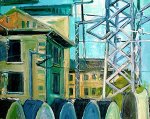CAPRICORNO GALLERY | ARTIST
Salvatore Garau Giovanni Frangi Luca Pignatelli Ercole Pignatelli Marisa Lambertini Velasco Ugo Riva Marco Petrus Soonja Han Flaminia Mantegazza Carlo Ramous Tommaso Cascella Heinrich Nicolaus Geraldina Garattoni Giovanni Calabrese Anna Maria Curto Federico Guida Daniele Peruzzi-fotografo Vittore Frattini Monica Marioni Maura Bruno Fiammetta Giuliani Michela Crisostomi DormiceGiovanni Frangi
GIOVANNI FRANGI Giovanni Frangi was born in 1959 in Milan, where he lives and works. After a series of collective exhibitions, in 1983 he had his first personal exhibition at the Gallery “La Bussola” in Turin. Soon he began to attract the attention of critics, poets and writers, such as Achille Bonito Oliva, Piero Bigongiari, Aldo Busi, Alda Merini, Marco Di Capua, Vittorio Sgarbi who wrote critical texts, essays and poems for his catalogues between 1986 and 1997. During these same years Frangi also exhibited abroad: in Bern, Barcelona, New Orleans, Lausanne and Hong Kong. In 1996 Giovanni Frangi won the Chamber of Deputies Award, after participating in the XIIth Rome Quadrennial. In 1998 Frangi won the Borlotti Prize and again went abroad the following year: to Hong Kong and at the Schalkwijk Contemporary Art Center, in Utrecht. The following October, the artist exhibited for the first time at Palazzo delle Stelline in Milan, this cycle was called Il richiamo della foresta (The Call of the Wild). It consisted of thirteen large paintings which, placed like theatrical wings, represented a forest. In 2001 Frangi exhibited in Los Angeles a cycle of twelve paintings inspired by the months of the year. Since the late nineties Frangi is one of the four protagonists of the Officina Milanese, a group formed around the critic Alessandro Riva, together with Marco Petrus, Luca Pignatelli andVelasco. During this period the artist eviscerated the power of colour in landscapes marked by the passing of the seasons climate, light. After this, Frangi directed his interest towards the issues of water, islands, and ports. It is this latter period, known to critics and the public as the cycle of the islands, the artist participated as one of the protagonists of the first three stages of the project Italian Factory, la nuova scena artistica italiana, organized in 2003 as a side event at the 50th Venice Biennial, at the European Parliament in Strasbourg and at Palazzo della Promotrice delle Belle Arti in Turin. The beginning of Frangi’s artistic career is related in some way to the Northern expressionist culture and then to the luministic post-impressionist research. But reality was what really interested him and what he wanted to investigate. At the same time he understood that the problem of figuration and realism of the figure and landscape painting was a false problem, because the so called inner vision of his work allowed him to discover a different reality, and to express it without adhering to real objects. Frangi arrives to possess his images after they have been destroyed, crushed and turned into lyrical visions of the everyday life.









